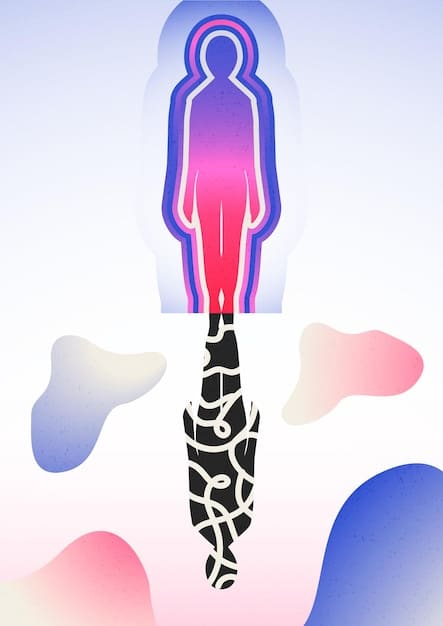Vipassana Meditation: A Beginner’s Guide to Inner Peace

Vipassana meditation, an ancient Indian practice, is a technique for self-discovery and attaining inner peace through focused awareness of breath, body sensations, and thoughts without judgment, promoting insight into the nature of reality.
Embark on a transformative journey with Vipassana meditation, an ancient practice that’s increasingly relevant in our modern lives. This beginner’s guide unveils the core principles, techniques, and benefits of Vipassana, offering a pathway to self-discovery and lasting inner peace.
Understanding Vipassana Meditation
Vipassana, meaning “to see things as they really are,” traces its roots back to ancient India and is one of the oldest meditation techniques. It’s a path of self-transformation through self-observation, aiming to eradicate mental impurities and cultivate a balanced mind.
The Core Principles of Vipassana
At its heart, Vipassana is about observing the present moment without judgment. It emphasizes the interconnectedness of mind and body, teaching practitioners to become intimately aware of their sensations, thoughts, and emotions.
Vipassana vs. Other Meditation Techniques
While other meditation forms may focus on concentration or visualization, Vipassana emphasizes insight. It’s not about escaping reality but understanding it deeply. Here’s a simple comparison:
- Concentration Meditation: Focuses on training the mind to stay on a single point.
- Mindfulness Meditation: Cultivates awareness of the present moment, similar to Vipassana, but often lacks the same structured approach.
- Transcendental Meditation: Uses mantras to transcend thought and promote relaxation.

By understanding the different approaches to meditation, you can customize the path towards self discovery that best fits your unique needs.
In essence, Vipassana is a powerful tool for self-exploration, inviting us to see the world with greater clarity and acceptance.
Preparing for Your First Vipassana Session
Before diving into Vipassana, it’s wise to lay some groundwork. Preparation can significantly enhance your experience, making it more comfortable and productive.
Choosing the Right Environment
Select a quiet and distraction-free space where you can sit undisturbed. Minimize noise and visual clutter to create a peaceful atmosphere. Consider using earplugs or a white noise machine if external sounds are unavoidable.
Optimal Timing for Practice
Consistency is key in Vipassana. Determine a time of day when you’re least likely to be interrupted and can devote your full attention to the practice. Many find early morning or late evening to be ideal.
Setting Your Intention
Before beginning, take a moment to clarify your intention for the session. What do you hope to gain from this practice? Setting a clear intention can help guide your focus and motivation. Consider these points:
- Reducing Stress: Intending to ease stress can center your mind on bodily sensations.
- Cultivating Awareness: A clear intention towards awareness helps ground you in the current moment.
- Gaining Insight: An intention towards deeper understanding of thoughts and emotions can be helpful.
Proper preparation sets the stage for a more meaningful and effective Vipassana experience.
The Basic Techniques of Vipassana
Vipassana primarily revolves around the observation of breath and body sensations. These simple yet profound techniques form the backbone of the practice.
Breath Awareness
Begin by focusing your attention on the natural rhythm of your breath. Notice the sensation of the air entering and leaving your nostrils or the rise and fall of your abdomen. There’s no need to control or alter your breath; simply observe it.
Body Scan Meditation
Systematically scan your body, paying attention to any sensations that arise – tingling, pressure, warmth, or coolness. Move your attention slowly from head to toe, acknowledging each sensation without judgment. If your mind wanders, gently redirect it back to the present moment.

Dealing with Distractions
It’s natural for thoughts and emotions to arise during Vipassana. When distractions occur, acknowledge them briefly, and then gently redirect your attention back to your breath or body sensations. Avoid getting carried away by the content of your thoughts.
Mastering these basic techniques is essential for deepening your Vipassana practice and unlocking its potential benefits.
Common Challenges and How to Overcome Them
As with any new practice, Vipassana can present some initial challenges. Recognizing these obstacles and having strategies to address them is crucial for sustained progress.
Dealing with Restlessness
Restlessness is a common experience, especially in the beginning. If you find yourself fidgeting or unable to sit still, try adjusting your posture or focusing your attention more intently on your breath. Remember, it’s okay to take short breaks if needed.
Managing Mind Wandering
The mind’s tendency to wander is inevitable. When you notice your thoughts drifting away, gently guide your attention back to your breath or body sensations. The key is to approach this process with patience and self-compassion.
Working with Difficult Emotions
Vipassana can sometimes bring difficult emotions to the surface. When this happens, avoid suppressing or judging these feelings. Instead, observe them with curiosity and acceptance, recognizing that they are temporary and part of the human experience.
- Self-Compassion: Treat yourself with the same gentle care you’d offer a friend.
- Mindful Acceptance: Acknowledge the presence of your true emotions instead of suppression.
- Observation: Recognize the fleeting nature of your emotions.
By facing these challenges with awareness and resilience, you can deepen your Vipassana practice and cultivate greater emotional well-being.
The Benefits of Regular Vipassana Practice
Regular engagement with Vipassana meditation can yield a multitude of benefits, positively impacting your mental, emotional, and physical well-being.
Reduced Stress and Anxiety
Vipassana has been shown to reduce stress and anxiety by promoting relaxation and cultivating a sense of inner calm. By observing your thoughts and emotions without judgment, you can gain a greater sense of control over your reactions to life’s challenges.
Enhanced Self-Awareness
Through Vipassana, you become more attuned to your inner landscape, developing a deeper understanding of your thoughts, emotions, and patterns of behavior. This increased self-awareness can lead to greater empathy, compassion, and personal growth.
Improved Focus and Concentration
By training your mind to stay present and focused, Vipassana can enhance your ability to concentrate and pay attention in daily life. This can improve productivity, creativity, and overall cognitive function.
From enhanced focus to reduced stress, integrating Vipassana into your routine can prove to be a life enhancing journey.
Integrating Vipassana into Your Daily Life
While formal meditation sessions are valuable, the true power of Vipassana lies in its ability to be integrated into your daily life. By bringing mindfulness to your everyday activities, you can cultivate a greater sense of presence and awareness.
Mindful Activities
Practice bringing your full attention to routine tasks such as eating, walking, or washing dishes. Notice the sensations, sounds, and sights without judgment. This can transform mundane activities into opportunities for mindfulness.
Applying Vipassana in Interactions
When interacting with others, practice listening with empathy and awareness, paying attention to your own reactions and judgments. This can improve your communication skills and strengthen your relationships. Maintain focus with strategies like:
- Active Listening: Pay attention to their words and body language.
- Empathy: Put yourself in their shoes to maintain mindful interaction.
- Non-Judgment: Try to understand and observe their perspective without judgment.
Maintaining Consistency
Set realistic goals for incorporating Vipassana into your daily life, starting with small, manageable steps. Be patient with yourself, and remember that every moment of mindfulness counts.
By weaving Vipassana into the fabric of your daily life, you can cultivate a more mindful, compassionate, and fulfilling existence.
| Key Point | Brief Description |
|---|---|
| 🧘 Breath Awareness | Focus on the natural rhythm of your breath without trying to control it. |
| 🤔 Body Scan Meditation | Systematically scan your body, paying attention to sensations without judgment. |
| ✨ Mindful Activities | Bring full attention to routine tasks to cultivate a better presence in daily life. |
| 😌 Stress Reduction | Manage stress by developing a deeper calm, control, and understanding. |
Frequently Asked Questions about Vipassana
Vipassana is an ancient Indian meditation technique focusing on observing the present moment without judgment. It involves awareness of breath, body sensations, and thoughts to gain self-awareness.
As a beginner, start with 10-15 minute sessions. Gradually increase the duration as you become more comfortable and find your focus improving with practice.
Yes, Vipassana can easily be practiced at home. Find a quiet space, set your intention, and follow breath and body awareness techniques. Consistency trumps location.
Mind wandering is normal. Gently acknowledge where your thoughts drift to before redirecting your attention back to your breath or body sensations, without getting frustrated.
Some individuals may find it challenging to confront difficult emotions, and those with a history of mental health issues should approach Vipassana with caution or under professional guidance.
Conclusion
Vipassana meditation is a profound tool for self-discovery and inner peace. By understanding its principles, practicing its techniques, and integrating it into your daily life, you can unlock a path to greater awareness, compassion, and well-being. Start your Vipassana journey today and discover the transformative power of presence.





